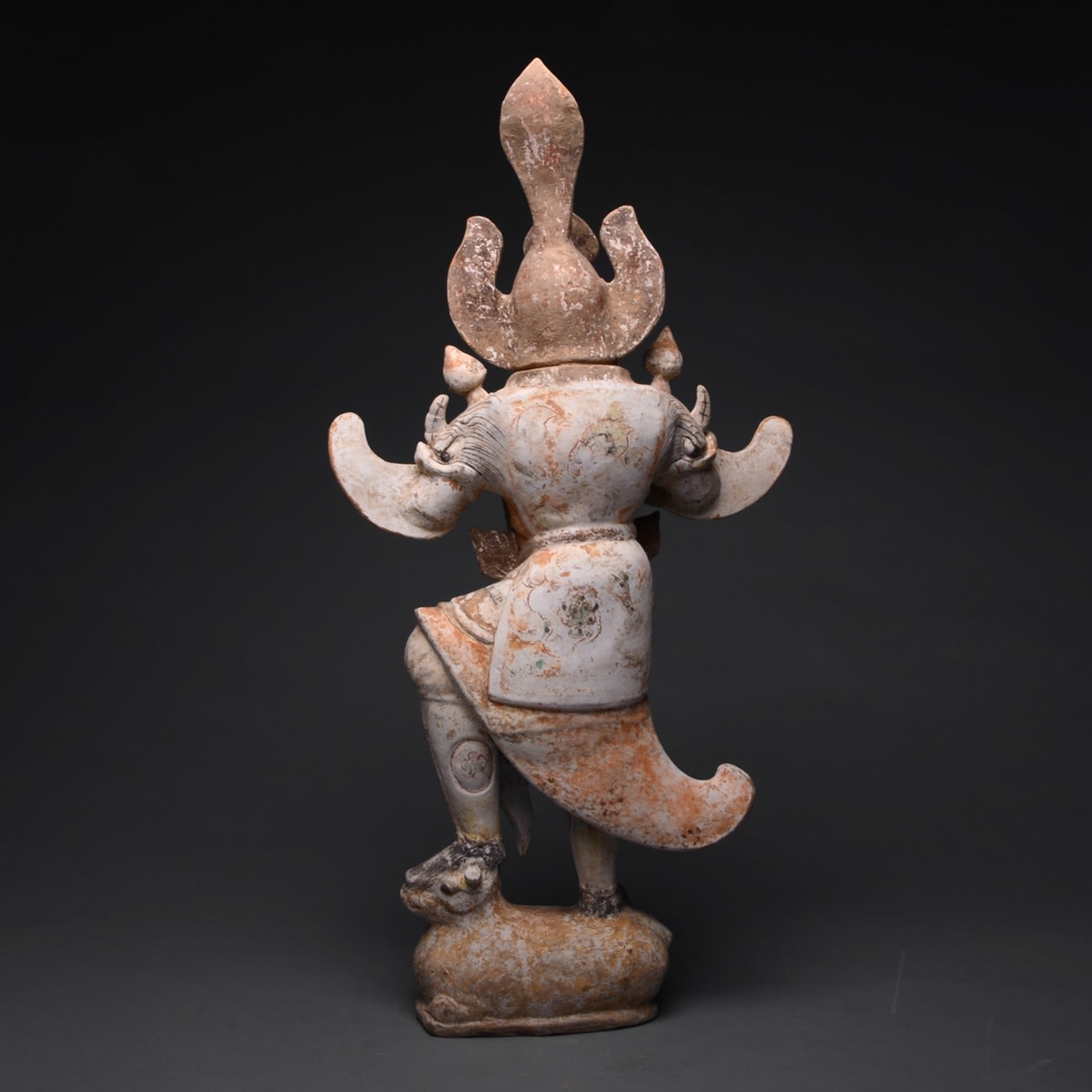T'ang Gilt and Painted Terracotta Sculpture of a Lokapala, 618 CE - 906 CE
Painted Terracotta
height 58.4 cm
height 23 in
height 23 in
H.925
Further images
The T’ang Dynasty was an era of unrivalled wealth and luxury. The country was successfully reunified and the borders were expanded, pushing Chinese influence into new lands. Confucianism became a...
The T’ang Dynasty was an era of unrivalled wealth and luxury. The country was successfully reunified and the borders were expanded, pushing Chinese influence into new lands. Confucianism became a semi-religious instrument of the state; yet Buddhism continued to flourish, spreading into Korea and Japan. The arts reached new levels of sophistication. Poetry and literature flourished under the enlightened rulers. The Silk Road brought fortunes into China. Precious treasures were imported on the backs of camels from far away lands and bartered for Chinese silk, medicinal herbs, and pungent spices. T’ang China was a multicultural empire where foreign merchants from across Central Asia and the Middle East settled in the urban centers, foremost among them the thriving capital of Chang’an (modern X’ian), a bustling cosmopolitan center of over two million inhabitants. Foreign traders lived next to native artisans and both thrived. New ideas and exotic artistic forms followed alongside. The T’ang Dynasty was a cultural renaissance where many of the forms and objects we now associate with China were first created. Moreover, this period represents one of the greatest cultural outpourings in human history.
During the Tang Dynasty, restrictions were placed on the number of objects that could be included in tombs, an amount determined by an individual's social rank. In spite of the limitations, a striking variety of tomb furnishings have been excavated. Entire retinues of ceramic figures - animals, entertainers, musicians, guardians - were buried with the dead. Many of the objects reflect Tang China's extraordinary amount of contact with foreigners, bringing into China influences that were then adapted and absorbed into its culture. One of these influences is apparent in this figure that corresponds to Buddhist warrior deities that assume a mortuary role in China but also serve as protectors of Buddhist temples. Known as "Protector of the Burial Vault" or "Protector of the Burial Ground," the fierce, this armored guardian stands atop a grotesque demon. This stance symbolizes the heavenly king's authority and responsibility as protector of the tomb.
A remarkable amount of this sculpture’s original pigment has survived the ravages of time intact, perhaps most visible in the spectacular vibrant red, orange, and green floral decorations that adorn his armor. Traces of the gilding are also visible, attesting to the luxurious nature of this sculpture. According to one Chinese tradition explaining their origin, Emperor Taizong, when ill, was threatened by ghosts outside of his room screeching and throwing bricks and tiles. When his general Jin Shubao (Chin Shu-pao) and a fellow officer came to stand guard the activity of the ghosts ceased. The grateful emperor had portraits of the two men hung on either side of his palace gates, and thereafter their images became widespread as door-gods. Originally, he would have brandished a weapon fabricated in a material such as wood that has deteriorated over the centuries. Looking unto his stern face and flaming hair and gazing into his fierce eyes, we understand why such works were intended to frighten away tomb robbers and evil spirits. Yet despite his intimidating nature, he does not repel us; instead, we are attracted to his artistic mastery and intriguing history.
During the Tang Dynasty, restrictions were placed on the number of objects that could be included in tombs, an amount determined by an individual's social rank. In spite of the limitations, a striking variety of tomb furnishings have been excavated. Entire retinues of ceramic figures - animals, entertainers, musicians, guardians - were buried with the dead. Many of the objects reflect Tang China's extraordinary amount of contact with foreigners, bringing into China influences that were then adapted and absorbed into its culture. One of these influences is apparent in this figure that corresponds to Buddhist warrior deities that assume a mortuary role in China but also serve as protectors of Buddhist temples. Known as "Protector of the Burial Vault" or "Protector of the Burial Ground," the fierce, this armored guardian stands atop a grotesque demon. This stance symbolizes the heavenly king's authority and responsibility as protector of the tomb.
A remarkable amount of this sculpture’s original pigment has survived the ravages of time intact, perhaps most visible in the spectacular vibrant red, orange, and green floral decorations that adorn his armor. Traces of the gilding are also visible, attesting to the luxurious nature of this sculpture. According to one Chinese tradition explaining their origin, Emperor Taizong, when ill, was threatened by ghosts outside of his room screeching and throwing bricks and tiles. When his general Jin Shubao (Chin Shu-pao) and a fellow officer came to stand guard the activity of the ghosts ceased. The grateful emperor had portraits of the two men hung on either side of his palace gates, and thereafter their images became widespread as door-gods. Originally, he would have brandished a weapon fabricated in a material such as wood that has deteriorated over the centuries. Looking unto his stern face and flaming hair and gazing into his fierce eyes, we understand why such works were intended to frighten away tomb robbers and evil spirits. Yet despite his intimidating nature, he does not repel us; instead, we are attracted to his artistic mastery and intriguing history.







